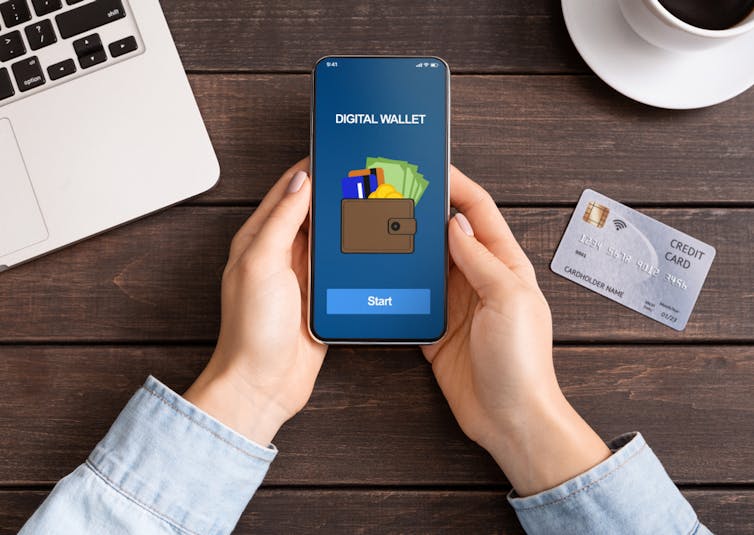
Like many other countries, the UK has developed a plan for a central bank digital currency (CBDC). A digital pound would essentially act like an online form of cash suitable for everyday payments. It would not earn any interest like a standard savings account (or even some current accounts), but it could increase access to financial services in the UK.
The Bank of England recently proposed a general framework for how a digital pound would work. It has suggested an ambitious timeline for introducing one by 2025. You have until June 7 2023 to tell the bank what you think of its plan.
The success of a UK CBDC will largely depend on whether the benefits of offering a digital currency outweigh the costs of creating and rolling out the infrastructure needed to support the new payment system.
There are clear benefits to CBDCs, such as increasing financial inclusion by providing an easier way for the UK’s 1.2 million unbanked residents to register for banking services. The online wallets that would hold people’s digital pounds could also be used by the government to make “fiscal transfers” such as passing tax subsidies or support payments on to households and businesses.
But the Bank of England’s current proposal is also seeking answers to some questions about a digital pound. In particular, how (or if) it could coexist alongside other digital currencies such as cryptocurrency assets. While the bank suggests several models, broadly speaking this could help reduce systemic risk in the crypto sector and further increase banking options for UK consumers.
Read more: What are stablecoins? A blockchain expert explains
The Bank of England’s CBDC consultation paper specifically mentions stablecoins. These are digital assets that are issued by private companies, unlike a traditional currency which is issued by a government. And unlike digital currencies such as bitcoin, the value of a stablecoin is pegged to a stable asset like the US dollar or British pound – but what about a digital pound?
How stablecoins could complement digital pounds
The bank talks about the overlap between what a stablecoin and a digital pound could offer. It argues they could “coexist” in a mixed payments economy. It compares this to how we use both cash and bank accounts in the same payment system right now, pointing to technology developments such as ATMs that have made this coexistence even easier over the years.
Stablecoins would need to be “fully backed with high-quality and liquid assets” in order to complement a digital pound, according to the bank. It adds:
In contrast to the digital pound, stablecoins, regardless of their backing asset, would be a liability of the private-sector issuer rather than a claim on the central bank. That means they would be private money, like commercial bank deposits.
It also suggests a model in which these backing assets could be “held entirely with the central bank”, adding that this would make the stablecoin “economically similar to the digital pound” and reduce financial risk.
If the digital currency was used to back a stablecoin, this would mean that the issuer would provide holders with stablecoin tokens based on the value of digital pounds that could be used by customers for payments (both domestic and international) as well as trading in cryptocurrencies. These private forms of money would operate on the blockchain, which helps make payments easier and less costly. In some countries, stablecoins are already being used as a hedge against inflation and macroeconomic uncertainty.
Regulating cryptocurrencies
This could also have benefits for the crypto industry. Currently, stablecoins are managed by private banks or organisations that are not regulated and audited. But a stablecoin backed by a digital pound in an account held with the central bank would be much more transparent and trustworthy. The central bank could regularly audit stablecoin providers’ reserves. Legislators could also impose capital requirements, for example mandating the percentage of issuers’ reserves to be kept in the account with the central bank.
But there is a trade-off here: extreme capital requirements could affect the profitability of stablecoins. Since they are typically linked to interest-bearing assets like Treasury bonds, they can make money from their holdings – that is, the assets held against the stablecoins they issue.
In contrast, a digital pound-backed stablecoin issuer would be unlikely to earn interest on its account at the central bank. While a typical bank such as Lloyds has reserve accounts at the central bank that earns the base rate, it is unlikely that the Bank of England would give a stablecoin provider the same kind of account. This would entail being subject to the same regulations, which could affect the flexibility that crypto asset providers tend to value.

Stablecoins backed by a digital currency held at the central bank could certainly address some of the systemic issues surrounding this type of crypto asset. Over the past year, a major stablecoin has collapsed in value. This typically happens when a market event prompts holders to rush to withdraw their holdings and the issuer has difficulties fulfilling so many redemptions at once.
If issuers were holding a certain percentage of liquid digital currency reserves at the central bank, this would ensure they had funds to process redemptions or withdrawals while maintaining the coin’s value against the digital pound. And even if an issuer bankruptcy did occur, a central bank could also provide insurance to stablecoin customers to protect their assets to a certain level.
Much like cash and bank accounts, it is possible that digital assets and stablecoins could coexist and even complement each other. Further, a digital pound could shine a light on the growing role of private money in the economy. This would help to make the financial system more secure while also fostering financial inclusion.
Ganesh Viswanath-Natraj does not work for, consult, own shares in or receive funding from any company or organisation that would benefit from this article, and has disclosed no relevant affiliations beyond their academic appointment.
This article was originally published on The Conversation. Read the original article.







